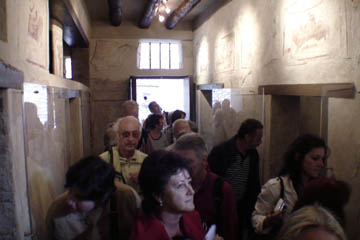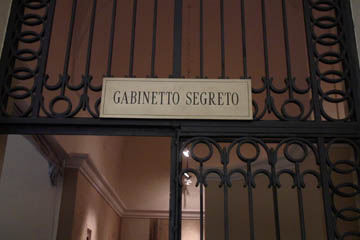The Secret Cabinet's Secrets
On August 20, 79 AD, the mountain that overlooked the Bay of Naples quivered as a low rumble that many thought was thunder reverberated across the peaceful landscape. Birds fell silent and cattle stirred uneasily, but in the bustling streets of Pompeii few even heard the sound. Certainly no one was perturbed enough to cancel his engagements for the next few days or to do anything so silly as leaving the city for the long trek back to Rome.
The people of Pompeii lived for pleasure - either enjoying it or providing it. The whole region around the bay, from the hot springs at Baiae with the curious Phlegraean Fields nearby, to the luxurious villas that overlooked the imperial retreat on the Isle of Capri, was the most expensive real estate in Italy. Famous men of the past, such as Pompey and Cicero, had built lavish homes along the coast and the would-be famous men of the present were no less eager to enjoy the scenic splendours and human pleasures of life on Rome's Riviera.
In Pompeii itself the wealthy bought up whole city blocks, tore down the houses of the less well-off and erected massive mansions with every possibile convenience - running water, frescoed walls, elegant statuary and private toilets. If they didn't have private baths, it was only because bathing was a social occasion and the whole essence of it was not cleanliness but seeing and being seen by the leaders of society.
The streets of Pompeii were lined with shops selling everything from regional delicacies such as sea food to the staples of life such as bean stew. Wine and women were equally available at reasonable prices and those disposed for a bit of song had only to stroll down the street to the Odeon where they could be entertained by anything from a Greek tragedy to a Roman burlesque or an aspiring author reading his latest book to a bored audience of friends, clients and impecunious relatives.
All that changed on August 24 when the mountain suddenly roared. Horrified crowds watched as, in apparent slow motion, the gentle, vine-covered slopes ripped open and a vast column of smoke blasted into the sky. A few turned to flee, a few rushed first into their houses to snatch up the nearest treasures, the majority stood in stunned silence, gaping at the marvel.
Only the first escaped when the hail of small stones - lapilli - began to rain down on the doomed city. Those who had gone into their houses found their exits blocked by drifts of ash or by fallen rafters as roofs collapsed under the weight of ash and stone. Those who had remained in the open were overwhelmed by a roiling cloud of sulphurous gas that turned day into night and choked them where they stood. Only the most fleet of foot were able to outrun the disaster that buried Pompeii beneath thirty feet of volcanic ash - and then only if they had been fortunate enough to head in the right direction.
Some, perhaps, ran towards the nearby town of Herculaneum, hoping to find safety in the boats that lined its harbour. They little knew that a pyroclastic cloud of red-hot pumice was even then streaming down the slopes of Vesuvius, headed directly for the town. If any made it inside the walls they were immediately buried by the torrent of lapilli and ash, so hot that the liquid in their bodies turned instantly to steam, bursting their skin and exploding their skulls.
Overwhelmed by the scale of the disaster, the Romans literally did nothing apart from provide limited aid to the few lucky survivors. There was no attempt to dig out the houses and the two cities - and no doubt many other smaller towns and villages - remained buried. Over the centuries their very existence was forgotten and it was only in the 1700s that villagers, digging a well, discovered a statue and presented it to their overlord, thus alerting the world to the existence of buried treasure.
Deliberate excavations began in 1748 under the direction of Rocco Gioacchino de Alcubierre, an engineer employed by King Charles III of Naples. He worked by digging tunnels out from a shaft until he encountered a wall, then digging along the wall to a door or gateway. The aim was to find statuary which was then taken to the surface and used to decorate the royal palaces and gardens.
In April of that year de Alcubierre's workmen discovered the first Pompeian fresco and as it was impossible to remove a plastered wall they had no choice but to leave it down there and make some provision for the hundreds of visitors who flocked to see it. It soon became apparent that tunnels were too dangerous and that the amount of interest justified the enormous labour of removing the tens of feet of soil and volcanic material which lay above the buried streets and houses, and so the work of clearing the city began.
Both Pompeii and the mountain which destroyed it became tourist attractions. In 1880 a consortium of enterprising Neapolitans built a cable railway to the summit of Vesuvius, hoping to attract those visitors who had been put off by the arduous climb up the mountain. The successful completion of this technological feat was celebrated in a song that quickly swept the world - "Funiculi, funicula". (Unfortunately the mountain was not the static thing some had thought it to be and earth movements continually disturbed the line, which was finally destroyed in the massive eruption of 1940.)
The excavations in Pompeii have been more enduring, though even they have passed through difficult times, none more so than April 1943 when Allied airman mistook the shadows of the ruined buildings for a camouflaged panzer battalion and dropped 150 bombs around the Forum, destroying many of the buildings which had been carefully reconstructed over the years.

|
| A throng of tourists crowds into Pompeii's famous - and tiny - brothel. It is hard to know whether they are thrilled or disappointed by the infamous frescoes. |
As well as the vistas of streets lined with ruined houses, an added attraction was the salacious nature of many of the discoveries. A door handle in the shape of an erect phallus was just too shocking to be put on public display, but rumours of such things quickly spread among the tourists and the guards were not slow to cash in on the somewhat prurient interest shown by staid Victorians. The brothel, for example, though tightly locked and unmarked by any sign, could nonetheless be visited in exchange for a suitable tip and many of the guards, coming across a male visitor on his own, would lose no time in approaching and uttering the immortal hiss, "Hey, mistar!"
Although anyone with enough loose cash in his pocket could reasonably expect to gain access to the brothel, it was another matter entirely with the "Secret Cabinet". For this you needed the right connections, for the "Secret Cabinet" was a collection of erotica that was kept under lock and key by the King of Naples - and later by the town council - as too shocking for the general public to see but too interesting to be destroyed.

|
| The entrance to the infamous Secret Cabinet, now open to the public. |
Having heard quite a few bated-breath speculations about the contents of this sordid collection, I was surprised to find that it is now on open display in the Naples Archaeological Museum. As the slightly apologetic note at the entrance says, far more erotic things are available to the public today - and having received a supposedly family orientated Christmas catalogue that offers phallus-shaped sweets and a soap dispenser in the form of a pair of breasts, I can only agree - and the contents of the "Secret Cabinet" are tame by comparison.
Which is not to say that they would be to everyone's taste and maiden aunts are best encouraged to spend their time in the downstairs galleries and exploring the Egyptian collection. Nevertheless, while the objects themselves are pretty tame and rapidly become boring, their existence and the thoroughly promiscuous and immoral society that generated them rather underline the denunciations of the Apostle Paul in the first chapter of his letter to the Romans. Given the Christian - and, indeed, Jewish - viewpoint which says that sex is the glue which binds a married couple together, the casual but enthusiastic immorality of the Romans was not only shocking but a positive evil.
The twenty-first century is just as immoral and is rapidly becoming just as blatant, and the social problems about which ancient Roman moralists complained are manifesting themselves once again. History does go in cycles and while the cynic in me is not at all surprised that humans never learn, the optimist hopes that some few might indeed listen to St Paul and avoid the mistakes of the past.
© Kendall K. Down 2009





